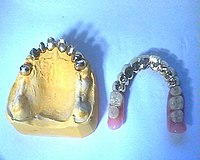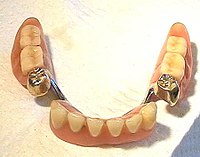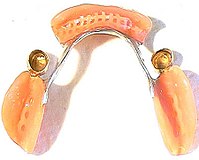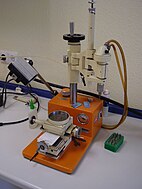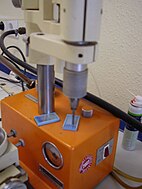Telescopic prosthesis
A telescopic prosthesis is a partial prosthesis that is attached to telescopic crowns . The telescopic crowns also have a supporting and holding function. It is a removable denture that is used to replace missing teeth. It is therefore assigned to the combined denture . Telescopic prostheses are complex to manufacture. In Germany, they are part of the standard procedure for replacing missing teeth.
In the English-speaking world, telescopic crowns are referred to as "German crowns", because they could not establish themselves abroad, especially because of the necessary technical know-how, and have remained a German peculiarity. Telescopic crowns are double crowns. They consist of two crowns placed one on top of the other. The inner crowns (primary telescope) are firmly cemented in place, the outer crowns (secondary telescope) are attached to the removable partial denture. The telescopic prosthesis is held in place by static friction between the primary and secondary crowns. The usability of abutment teeth for a restoration with telescopic crowns depends on the abutment value .
Manufacturing
When preparing (grinding) the abutment teeth (comparable to the preparation of abutment teeth for bridge dentures ), all the ground surfaces of the teeth must be designed parallel to one another so that the finished construction has a common insertion direction. The dental technician can perform in the technical implementation only small corrections to the uniform insertion direction by the wall thickness of the primary crowns of telescopic crowns in places, something is made thicker. This can again cause aesthetic problems at the crown margins of the primary parts.
After the primary crowns have been manufactured (modeling and casting), their outer walls are milled parallel to each other. For this purpose, the plaster model with the attached primary crowns is fixed on a "plate", the plate stands on a ball joint and is adjusted until a common insertion direction is found for all primary parts. Then the ball joint is fixed and in this position the outer walls of all primary parts are ground in parallel with a special milling machine. This milling machine has a horizontally adjustable clamping head, which is similar to a parallelometer . In a further step, the secondary crowns are modeled on the finished primary crowns and then cast from metal. The friction (pull-off force) is mainly controlled by the expansion of the mold. The dental technician can still make fine adjustments to the friction during finishing. After completion of the telescopic crowns, the model casting (prosthesis metal framework) is made to which the secondary parts are soldered or glued. In addition, "one-piece casting" is also possible, in which the outer telescopes are cast together with the prosthesis base.
Several treatment sessions are required to produce a telescopic prosthesis, as try-ins on the patient and new impressions of the jaw are required for each work step.
Implant-supported telescopic prostheses
Instead of your own abutment teeth, implants can also be used to support telescopic crowns, to which a partial denture is attached. In order to achieve a predictably good and long-term therapeutic success, at least four pillars should be present. Pay attention to a large support polygon . Thanks to the one-piece casting secondary technology, there are no weakening connections or joints between the external telescopes and the partial denture body.
Combines tooth- and implant-supported telescopic prostheses
If there are few teeth, they can be used together with additional implants to attach partial dentures using telescopic crowns. Long-term scientific studies show survival rates of over 95% after six years for tooth / implant-supported telescope restorations.
Purely implant-supported telescopic prostheses
In toothless upper and lower jaws, partial dentures can only be attached to implants. This requires four to six implants. Long-term scientific studies show good survival rates for such constructions. After 14 years, the implant survival rates were 98.9% and 77% of the prostheses were still intact.
materials
The primary and secondary crowns should be made from the same alloy. As an alternative to gold alloys , non-precious alloys (non-precious metal) are mostly made of chrome / cobalt / molybdenum alloys. Due to their properties, gold alloys can be processed with greater accuracy of fit, but they are associated with high precious metal costs. Another type of processing is electroplating . The primary part usually consists of a non-precious metal alloy or of zirconium dioxide and a secondary part made of electroplated gold. The secondary part is galvanically applied to the primary part. A conductive silver lacquer is applied for electroplating; the lacquer ensures conductivity and the defined distance between the primary and secondary parts. The quality of the fit cannot be achieved with conventional methods (casting).
advantages
The telescopic prosthesis is held securely by the telescopic crowns and is therefore extremely comfortable to wear. It is often sufficient to produce a skeletonized and therefore delicate palatal plate in the upper jaw to provide additional support for the prosthesis. With a favorable arrangement and usable condition of the remaining teeth, a palatal plate can be dispensed with in individual cases. The aesthetic results are better than with partial dentures held by brackets, since no visible brackets have to be used to attach the partial denture to the teeth. Such a partial prosthesis can also be expanded to include additional artificial teeth in the event of further tooth loss.
disadvantage
Since telescopic crowns are double crowns, they are often thicker than simple crowns. To counteract this, teeth are either ground down more, which can lead to pulpic discomfort (tooth nerve inflammation), or they are thicker. The increased space required for the double crowns and for the plastic veneer create considerable aesthetic problems in the case of small lower anterior teeth fitted with telescopic crowns. Other teeth treated in this way can also cause aesthetic problems. The veneer must be thicker than a comparable ceramic veneer due to the need to cover the metal framework underneath. The color of the plastic facing material is not as transparent and stable as that of ceramic facing. Ceramic veneers, however, are not indicated because of the high risk of flaking off with telescopic crowns.
forecast
According to an investigation by the University of Giessen, a new product was necessary in 4.7% of cases. 3.8% of the teeth had to be extracted. In most cases (47%), extraction was indicated because of a tooth fracture. The 90% probability of survival of the abutment teeth was 6.90 years. Participation in the recall had a significant influence on the survival time of the telescopic prosthesis and its abutment teeth. The prognosis depends on the abutment value of the abutment teeth.
Illustrations
Telescopic prosthesis from the underside (from krestal )
Individual evidence
- ↑ Reinhard Marxkors: Textbook of dental prosthetics . Deutscher Ärzteverlag, 2007, ISBN 978-3-7691-3353-0 , p. 8–.
- ↑ K.-U. Bochdam Restoring the toothless jaw with implant-supported telescopic prostheses - a clinical follow-up examination of 3i screw implants
- ↑ Tobias Ficnar, Dominik Suwelack: Strategic abutment increase: current implant-tooth-supported restoration concepts . In: ZMK , July 12, 2013. Retrieved May 7, 2015.
- ↑ E. Frisch, P. Ratka-Krüger, HJ. Wenz: Unsplinted implants and teeth supporting maxillary removable partial dentures retained by telescopic crowns: a retrospective study with> 6 years of follow-up . In: Clinical Oral Implants Research. 2014 Apr 16, doi: 10.1111 / clr.12407 (English).
- ↑ S. Rinke, D. Ziebolz, P. Ratka-Krüger, E. Fresh: Clinical Outcome of Double Crown-Retained Mandibular Removable Dentures Supported by a Combination of Residual Teeth and Strategic Implants. In: Journal of Prosthodontics , 2014 Sep 14, doi: 10.1111 / jopr.12214 (English).
- ↑ E. Fresh, D. Ziebolz, S. Rinke: Long-term results of implant-supported dentures over-retained by double crowns: a practice-based retrospective study after minimally 10 years follow-up. In: Clinical oral implants research. Volume 24, Number 12, December 2013, ISSN 1600-0501 , pp. 1281-1287, doi: 10.1111 / j.1600-0501.2012.02568.x , PMID 22882661 .
- ↑ Andrea Weber: Survival time analysis of telescope-anchored partial dentures with special consideration of the follow-up costs . (PDF; 1.45 MB) Diss. Uni Gießen, 2005


